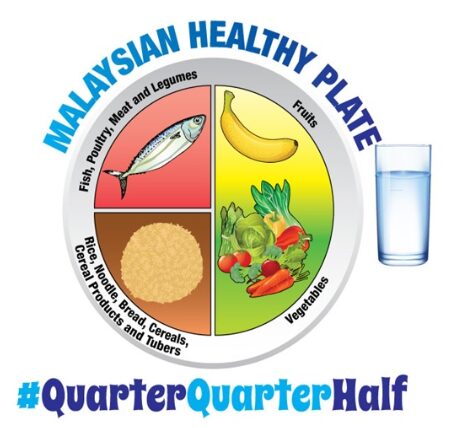
17 May Malaysian Healthy Plate: A Comprehensive Guide
Malaysian Healthy Plate: A Comprehensive Guide
By Island Hospital | May 17, 2024 12:00:00 PM
Medical Reviewer: Dietitian
When it comes to achieving the perfect balanced diet, most people probably think, “Just follow the food pyramid!”
However, while the food pyramid provides general guidelines for a balanced diet, it doesn’t directly address how to proportion each food group for every meal.
That’s when Malaysian Healthy Plate comes in.
As we celebrate World Nutrition Day this year, let’s take a closer look at this valuable dietary tool and how we can incorporate it into our daily diets.
What is the Malaysian Healthy Plate?

Source: Ministry of Health Malaysia
The Malaysian Healthy Plate (MHP) is a single-meal intake guide developed by the Ministry of Health of Malaysia.
It translates the dietary guidelines from the food pyramid into daily meals by showing the proportions of each food group to be consumed for one meal.
With this meal intake guide, you can easily establish healthy eating habits, ensuring you meet your nutritional needs for optimal health and well-being.
How to Plan Your Meals with the Malaysian Healthy Plate?
Planning balanced meals with the Malaysian Healthy Plate is straightforward – just follow the ‘Quarter, Quarter, Half’ (QQH) principle or ‘Suku, Suku, Separuh’ in Malay.
Visualise your plate divided into three sections. Fill half of your plate with vegetables and fruits, one-quarter with carbohydrates, and the remaining one-quarter with protein.
Continue reading to understand this single-meal intake guide in detail.
Vegetables and Fruits
The vibrant colours of vegetables and fruits make up half of the Malaysian Healthy Plate, taking centre stage on your plate.
This guideline is rooted in the numerous health benefits of vegetables and fruits. These nutrient powerhouses are packed with vitamins, antioxidants, minerals, and fibre, which play vital roles in supporting your overall well-being.
For instance, they can boost immunity, aid digestion, reduce the risk of obesity, and minimise the risk of chronic diseases, including diabetes, heart disease, and certain cancers [1].
Including vegetables and fruits of different colours in your diet is an easy way to obtain a complete range of nutrients, as different colours represent different nutrients.
Vegetables and fruits are divided into five main colour groups: red, orange or yellow, green, blue or purple, and white or brown.
Red vegetables and fruits like red peppers and watermelon are good sources of ellagic acid and lycopene (an antioxidant), which may reduce cancer risk. Orange or yellow produce like carrots and mangoes contain carotenoids, which are vital for eye health [2].
On the other hand, leafy greens like mustard green and spinach are rich in vitamin K, which is useful for bone health. Blue or purple options like blueberries and eggplant are packed with anthocyanins, powerful antioxidants beneficial for brain health and heart disease [2].
Lastly, white or brown fruits and vegetables like lychees and mushrooms are rich in phytonutrients with anti-tumour and anti-inflammatory properties.
But how can you ensure you’re meeting the suggested portion of vegetables and fruits?
Start your day with a colourful smoothie blending your favourite fruits or vegetables or sip on freshly squeezed juice. You can also snack on dried fruits or vegetable sticks with a healthy dip.
Also, don’t hesitate to ask the seller to add more vegetables to your dish when eating out. You can always request extra bean sprouts in your soup noodles or additional lettuce in your serving of mee goreng mamak (Indian-style fried noodles)!
Carbohydrates
Next, carbohydrates should take up one-quarter of your plate, as they can be broken down into glucose and become your primary energy source.
Aside from fuelling your physical activity and proper organ function, carbohydrates are vital in controlling blood sugar levels and metabolising insulin, cholesterol, and fats [3, 4].
However, not all carbohydrates are equally beneficial for your body. There are two types of carbohydrates: simple carbohydrates and complex carbohydrates.
Simple carbohydrates, also known as refined carbohydrates, have a simple chemical structure. Because of this, they can be easily broken down and used for energy, causing a rapid rise in blood sugar levels.
In the long term, high blood sugar levels may result in health issues affecting the heart, kidneys, eyes, and nerves. Hence, it is advisable to limit the consumption of simple carbohydrates, including candies, white bread, carbonated drinks, biscuits, and cakes.
On the other hand, complex carbohydrates or whole carbohydrates have a more complex chemical structure. As a result, they take a longer time to digest, leading to a more gradual increase in blood sugar levels.
Foods like sourdough bread, rolled oats, brown rice, wholemeal biscuits, and starchy vegetables like potatoes and sweet potatoes are excellent choices for incorporating complex carbohydrates into your diet.
Looking to eat less sugar? Learn more in our article on how to cut sugar intake (while keeping meals exciting!)
Protein
Just as the vibrant colours of vegetables and fruits occupy half the plate, and carbohydrates take up one-quarter, the final quarter is reserved for protein – an essential nutrient that plays a crucial role in various bodily functions.
For your body to use proteins, they must be metabolised into their simplest form, amino acids.
Your body uses amino acids to build and repair tissues like muscles, bones, skin, and hair. Amino acids are also used to produce enzymes, hormones, and antibodies, which are crucial for overall health and well-being [5].
We can obtain protein from two sources: animal and plant.
Animal proteins are a complete source of protein, containing all essential amino acids that can only be obtained through diet. Poultry, meat, fish, eggs, and dairy products (milk, yoghurt, cheese) are some animal protein sources.
However, some animal proteins, such as processed meats and red meats, can be high in saturated fats and cholesterol. When consumed in excess, this may raise the risk of health issues like hypertension and stroke.
Hence, to obtain the benefits of animal protein while minimising potential risks, it is advisable to consume lean cuts of meat with less visible fat.
On the other hand, plant proteins are generally lower in saturated fats. While plant proteins may lack one or more types of essential amino acids, consuming a diversity of plant-based proteins can provide a complete protein profile.
Beans, legumes, soybean products (tofu, tempeh, edamame), whole grains, seeds, and nuts are some food sources rich in plant proteins.
How to Make Your Diet Healthier?
In addition to following the Malaysian Healthy Plate guidelines, there are other meal-planning tips to keep in mind.
Plate Size
Using a plate that is too small may cause you to eat too little, while a plate that is too big can lead to overeating, potentially causing digestive problems and even being overweight.
Not sure what the right plate size is? Here’s a quick reference:
- Adults: 23cm or 9 inches (diameter)
- Children: 18 cm or 7 inches (diameter)
If you’re unsure about the measurements of your plates, compare them to a 9-inch pizza for adults and a 7-inch pizza for children. This should provide you with a good visual guidance.
Beverage Choices
When it comes to beverages, most of us drink something alongside our meals.
Plain water is always the best choice as it efficiently quenches thirst. However, if you prefer other beverage options, opt for non-sugary drinks such as milk, soy milk and fresh vegetable or fruit juices.
Choosing these healthier alternatives helps reduce calorie intake, aids in controlling body weight, and avoids the risk of dental caries associated with sugary drinks.
Cooking Methods
Do you know that the cooking method you choose can impact the overall nutritional value of your meal?
Certain cooking techniques, like deep-frying, can introduce unnecessary fats, oils, and unhealthy additives, while others can help preserve the natural goodness of your ingredients.
The table below shows some healthy cooking methods that minimise the need for excessive oils or unhealthy additives:
Cooking Methods | Explanations |
|---|---|
Steaming | |
Baking or Roasting | |
Grilling | |
Blanching | |
Poaching | |
Stewing or Braising |
Always experiment with different cooking techniques to find your favourites and add variety to your diet while promoting overall well-being.
Balance, Moderation, Variety
Lastly, remember to practise the BMV concept—balance, moderation, and variety—when planning your meals.
- Balance: Consume complete meals comprising all food groups, which include fruits and vegetables, carbohydrates, proteins, and fats.
- Moderation: Stick to the recommended portions of each food group for every meal.
- Variety: Eat a variety of foods throughout the day to ensure you obtain the different nutrients your body requires.
Schedule Your Health Check at Island Hospital
Indeed, the Malaysian Healthy Plate is a simple and efficient guide to balanced and nutritious eating.
If you wish to learn more about nutritional diets, reach out to Island Hospital’s team of clinical dietitians for professional consultation and treatment services.
However, even the healthiest eating habits cannot ensure perpetual well-being. This is where regular health screening becomes essential.
Consistent health screening plays a vital role in the early detection and prevention of chronic diseases that may not show immediate symptoms.
At Island Hospital, we offer a variety of affordable health screening packages aligned with your needs, with our team of healthcare professionals offering attentive guidance throughout the process.
We have over 70 full-time specialists across 9 Centres of Excellence, providing a wide array of health-related intervention and treatment services supported by cutting-edge medical equipment and technology.
Take charge of your health today by scheduling a comprehensive health screening at Island Hospital. Let us partner with you to safeguard your well-being.
FAQ
What is the Malaysia Healthy Plate?
The Malaysian Healthy Plate (MHP) is a single-meal intake guide showing the proportions of different food groups to be consumed for one meal.
It follows the ‘Quarter, Quarter, Half’ guideline by dividing the plate into three sections: half the plate for fruits and vegetables, one-quarter for carbohydrates, and one-quarter for protein sources.
Refer here to understand this single-meal intake guide in detail.
What is the difference between the food pyramid and the Malaysian Healthy Plate?
The traditional food pyramid represents different food groups in a hierarchical pyramid shape, with carbohydrates forming the base, followed by fruits and vegetables, protein sources, and fats.
In contrast, the Malaysian Healthy Plate is a more visually intuitive representation of a balanced meal, with each food group occupying a specific portion of the plate. This makes it easier to understand the recommended proportions and create a well-rounded meal.
Refer to this section to find out more about the Malaysian Healthy Plate.
What are the benefits of the Malaysian Healthy Plate?
The Malaysian Healthy Plate offers several benefits:
- Visual guidance: Providing a simple visual representation of a balanced meal, making it easier to understand and follow.
- Portion control: Dividing the plate into sections helps individuals gauge appropriate portion sizes for each food group in a meal.
- Adaptability: Applicable to different cultural cuisines and dietary preferences, making it versatile for diverse populations.
Visit this section to find out how to plan your meals using the concept of Malaysian Healthy Plate.
Can we entirely replace vegetables and fruits with juices?
No, it’s advisable not to replace eating whole vegetables and fruits with juicing them entirely. While juices can provide some nutrients, the juicing process strips away their dietary fibre, causing the juices to be absorbed more rapidly into the bloodstream.
This will lead to quicker spikes in blood sugar levels, which, over time, may result in health issues affecting your heart, kidneys, eyes, and nerves.
For optimal health benefits, it’s best to consume whole vegetables and fruits rather than relying solely on their juices.
What are high GI and low GI foods?
The Glycemic Index (GI) measures how quickly a carbohydrate-containing food is broken down into glucose and raises blood sugar levels. Foods are classified as:
- High GI (more than 70): These foods are rapidly digested and absorbed, causing a spike in blood sugar levels. Examples include white bread, cookies, candies, and potato.
- Medium GI (55 to 70): These foods are digested and absorbed slower than high GI foods. Examples include wholemeal bread, Basmathi rice, corn, and muesli bar.
- Low GI (below 55): These foods are digested and absorbed more slowly, allowing the blood sugar levels to rise gradually. Examples include pasta, legumes, most fruits, non-starchy vegetables, and low-fat dairy foods.
Consuming low-GI foods is generally recommended as they help maintain stable blood sugar levels and promote better satiety and energy levels.
However, while we occasionally enjoying foods with higher glycaemic index, eating them with foods with high soluble fiber such as oats, beans, barley, and an assortment of fruits and vegetables will help to reduce the glycaemic loads of the meals.
Are all proteins good for you?
Yes, but the nutritional value and potential health impacts differ in protein sources.
Hence, it’s recommended to include a variety of protein sources, both plant-based and animal-based, in your diet while paying attention to portion sizes and overall nutrient balance.
Refer here to understand more about the differences between plant-based and animal-based proteins.
References
[1] Amao, I. (2018). Health benefits of fruits and vegetables: Review from Sub-Saharan Africa. In Asaduzzaman, Md., & Asao, T. (Eds.), Vegetables – Importance of quality vegetables to human health. IntechOpen. https://doi.org/10.5772/intechopen.74472
[2] Kar, S., Kundu, S., & Mal, D. (2021). Nutritional quality of coloured vegetables: A review. Journal of Nutraceuticals and Food Science, 6(9:37). DOI:10.36648/ipctn.21.06.37
[3] Clemente-Suárez, V. J., Mielgo-Ayuso, J., Martín-Rodríguez, A., Ramos-Campo, D. J., Redondo-Flórez, L., & Tornero-Aguilera, J. F. (2022). The burden of carbohydrates in health and disease. Nutrients, 14(18). https://doi.org/10.3390/nu14183809
[4] Holesh, J. E., Aslam, S., & Martin, A. (2023). Physiology, carbohydrates. StatPearls Publishing. https://pubmed.ncbi.nlm.nih.gov/29083823/
[5] I. Baum, J., Børsheim, E., R. Allman, B., & Walker, S. (2020). Health benefits of dietary protein throughout the life cycle. In Salanță, L.C. (Ed.), The health benefits of foods – Current knowledge and further development. IntechOpen. https://doi.org/10.5772/intechopen.91404






